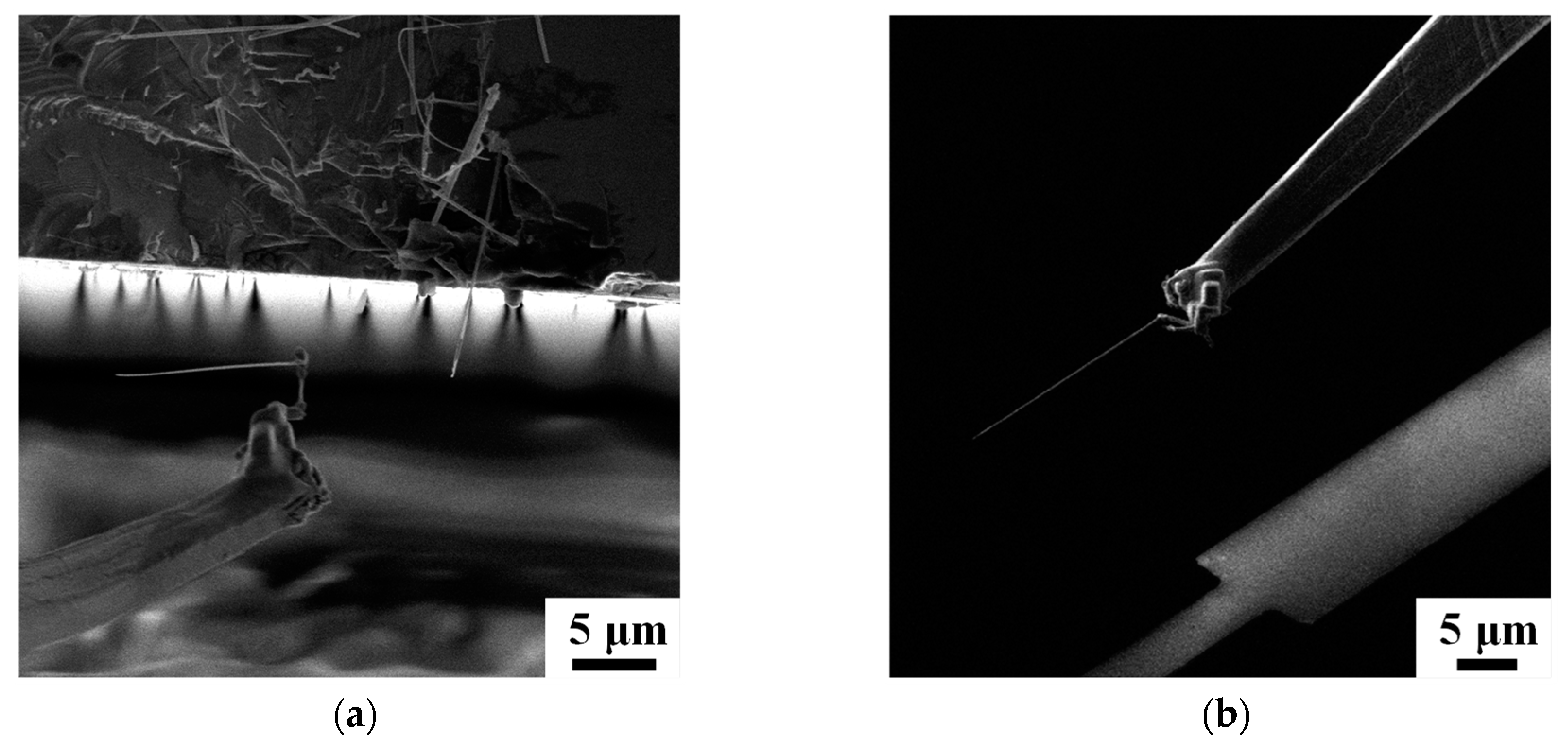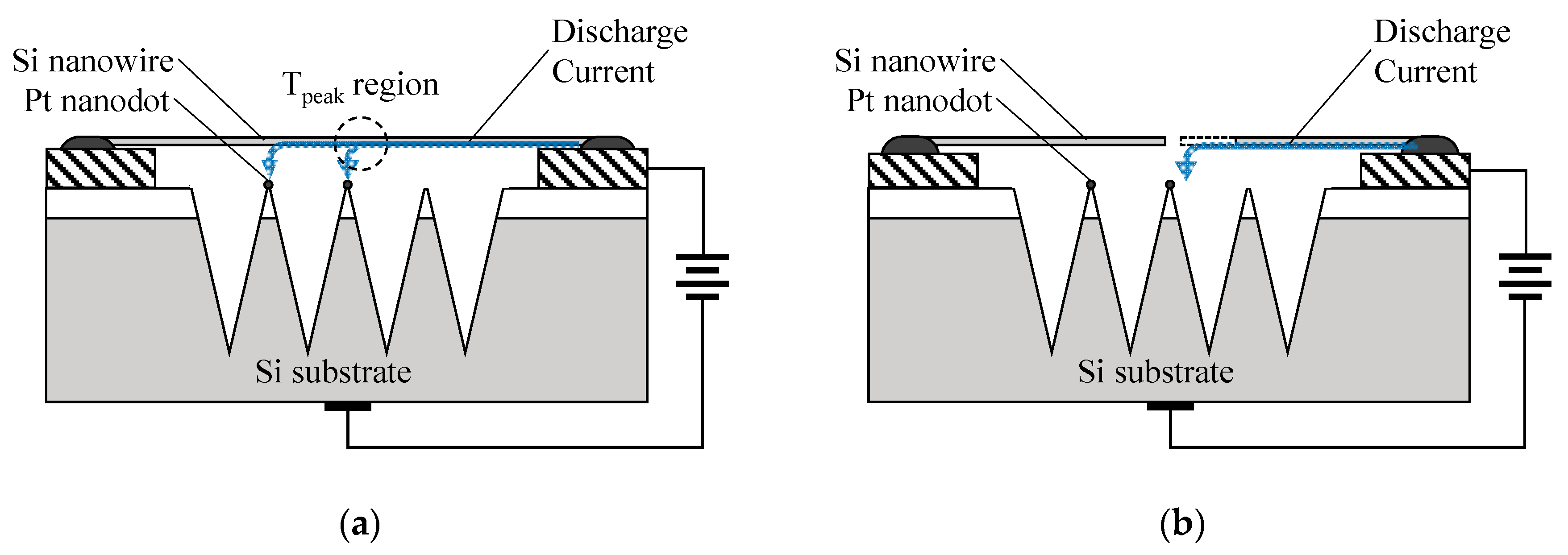Single-Nanowire Fuse for Ionization Gas Detection
Abstract
:1. Introduction
2. Materials and Methods
3. Results
4. Discussion
5. Conclusions
Author Contributions
Funding
Acknowledgments
Conflicts of Interest
Appendix A

Appendix B
- α: thermal accommodation coefficient from the ionized gas molecules with a mass density n to the nanowire, 2% [35]
- β: the fraction of energy injected to the gas discharge space from the external circuit, 0.5 [36]
- U: voltage loaded between the nanowire and the substrate, 3.75 V
- I: current intensity in the circuit loop, 500 nA (underestimated)
- n: gas density in the discharge space, for nitrogen in the standard environment, 1.2504 g/L
- V: volume of the core discharge space, 300 nm × 2.4 μm × 300 nm = 2.16 × 10−18 m3
- C: gaseous specific heat, for nitrogen, 1.038 J/g/K
Appendix C

References
- Duan, X.; Huang, Y.; Agarwal, R.; Lieber, C.M. Single-nanowire electrically driven lasers. Nature 2003, 421, 241–245. [Google Scholar] [CrossRef] [PubMed]
- Liu, Z.; Zhan, Y.; Shi, G.; Moldovan, S.; Gharbi, M.; Song, L.; Ma, L.; Gao, W.; Huang, J.; Vajtai, R.; et al. Anomalous high capacitance in a coaxial single nanowire capacitor. Nat. Commun. 2012, 3, 879. [Google Scholar] [CrossRef] [PubMed] [Green Version]
- Lupan, O.; Chow, L.; Pauporté, T.; Ono, L.K.; Cuenya, B.R.; Chai, G. Highly sensitive and selective hydrogen single-nanowire nanosensor. Sens. Actuators B Chem. 2012, 173, 772–780. [Google Scholar] [CrossRef]
- Zhang, D.; Liu, Z.; Li, C.; Tang, T.; Liu, X.; Han, S.; Lei, B.; Zhou, C. Detection of NO2 down to ppb Levels Using Individual and Multiple In2O3 Nanowire Devices. Nano Lett. 2004, 4, 1919–1924. [Google Scholar] [CrossRef]
- Moorthy, B.; Baek, C.; Eun Wang, J.; Jeong, C.K.; Moon, S.; Park, K.-I.; Kim, D.K. Piezoelectric energy harvesting from a PMN–PT single nanowire. RSC Adv. 2017, 7, 260–265. [Google Scholar] [CrossRef]
- Seo, M.-H.; Yoo, J.-Y.; Choi, S.-Y.; Lee, J.-S.; Choi, K.-W.; Jeong, C.K.; Lee, K.J.; Yoon, J.-B. Versatile Transfer of an Ultralong and Seamless Nanowire Array Crystallized at High Temperature for Use in High-Performance Flexible Devices. ACS Nano 2017, 11, 1520–1529. [Google Scholar] [CrossRef]
- Das, S.N.; Kar, J.P.; Choi, J.-H.; Lee, T.I.; Moon, K.-J.; Myoung, J.-M. Fabrication and Characterization of ZnO Single Nanowire-Based Hydrogen Sensor. J. Phys. Chem. C 2010, 114, 1689–1693. [Google Scholar] [CrossRef]
- Im, Y.; Lee, C.; Vasquez, R.P.; Bangar, M.A.; Myung, N.V.; Menke, E.J.; Penner, R.M.; Yun, M. Investigation of a Single Pd Nanowire for Use as a Hydrogen Sensor. Small 2006, 2, 356–358. [Google Scholar] [CrossRef]
- Singh, N.; Yan, C.; Lee, P.S. Room temperature CO gas sensing using Zn-doped In2O3 single nanowire field effect transistors. Sens. Actuators B Chem. 2010, 150, 19–24. [Google Scholar] [CrossRef]
- Shao, F.; Hoffmann, M.W.G.; Prades, J.D.; Morante, J.R.; López, N.; Hernández-Ramírez, F. Interaction Mechanisms of Ammonia and Tin Oxide: A Combined Analysis Using Single Nanowire Devices and DFT Calculations. J. Phys. Chem. C 2013, 117, 3520–3526. [Google Scholar] [CrossRef]
- Lupan, O.; Cretu, V.; Postica, V.; Ahmadi, M.; Cuenya, B.R.; Chow, L.; Tiginyanu, I.; Viana, B.; Pauporté, T.; Adelung, R. Silver-doped zinc oxide single nanowire multifunctional nanosensor with a significant enhancement in response. Sens. Actuators B Chem. 2016, 223, 893–903. [Google Scholar] [CrossRef]
- Gancarz, M.; Nawrocka, A.; Rusinek, R. Identification of Volatile Organic Compounds and Their Concentrations Using a Novel Method Analysis of MOS Sensors Signal. J. Food Sci. 2019, 84, 2077–2085. [Google Scholar] [CrossRef] [PubMed]
- Rusinek, R.; Gancarz, M.; Krekora, M.; Nawrocka, A. A Novel Method for Generation of a Fingerprint Using Electronic Nose on the Example of Rapeseed Spoilage. J. Food Sci. 2019, 84, 51–58. [Google Scholar] [CrossRef] [PubMed]
- Gancarz, M.; Wawrzyniak, J.; Gawrysiak-Witulska, M.; Wiącek, D.; Nawrocka, A.; Rusinek, R. Electronic nose with polymer-composite sensors for monitoring fungal deterioration of stored rapeseed. Int. Agrophys. 2017, 31, 317–325. [Google Scholar] [CrossRef] [Green Version]
- Singh, J.P.; Karabacak, T.; Lu, T.-M.; Wang, G.-C.; Koratkar, N. Field ionization of argon using β-phase W nanorods. Appl. Phys. Lett. 2004, 85, 3226–3228. [Google Scholar] [CrossRef]
- Yang, W.; Zhu, R.; Zong, X. ZnO Nanowire-Based Corona Discharge Devices Operated Under Hundreds of Volts. Nanoscale Res. Lett. 2016, 11, 90. [Google Scholar] [CrossRef] [Green Version]
- Sadeghian, R.B.; Kahrizi, M. A novel miniature gas ionization sensor based on freestanding gold nanowires. Sens. Actuators A Phys. 2007, 137, 248–255. [Google Scholar] [CrossRef]
- Liao, L.; Lu, H.B.; Shuai, M.; Li, J.C.; Liu, Y.L.; Liu, C.; Shen, Z.X.; Yu, T. A novel gas sensor based on field ionization from ZnO nanowires: Moderate working voltage and high stability. Nanotechnology 2008, 19, 175501. [Google Scholar] [CrossRef]
- Mohammadpour, R.; Ahmadvand, H.; Iraji zad, A. A novel field ionization gas sensor based on self-organized CuO nanowire arrays. Sens. Actuators A Phys. 2014, 216, 202–206. [Google Scholar] [CrossRef]
- Liu, H.; Yadian, B.; Liu, Q.; Gan, C.L.; Huang, Y. A hybrid nanostructure array for gas sensing with ultralow field ionization voltage. Nanotechnology 2013, 24, 175301. [Google Scholar] [CrossRef]
- Liu, H.; Wu, J.; Wang, Y.; Chow, C.L.; Liu, Q.; Gan, C.L.; Tang, X.; Rawat, R.S.; Tan, O.K.; Ma, J.; et al. Self-Organization of a Hybrid Nanostructure consisting of a Nanoneedle and Nanodot. Small 2012, 8, 2807–2811. [Google Scholar] [CrossRef] [PubMed]
- Huang, Y.Z.; Wang, S.G.; Wang, C.; Xie, Z.B.; Cockayne, D.J.H.; Ward, R.C.C. Self-organization of nanoneedles in Fe/GaAs (001) epitaxial thin film. Appl. Phys. Lett. 2006, 88, 103104. [Google Scholar] [CrossRef]
- Huang, Y.-Z.; Cockayne, D.J.H.; Ana-Vanessa, J.; Cowburn, R.P.; Wang, S.-G.; Ward, R.C.C. Rapid fabrication of nanoneedle arrays by ion sputtering. Nanotechnology 2008, 19, 015303. [Google Scholar] [CrossRef] [PubMed]
- Hochbaum, A.I.; Fan, R.; He, R.; Yang, P. Controlled Growth of Si Nanowire Arrays for Device Integration. Nano Lett. 2005, 5, 457–460. [Google Scholar] [CrossRef] [PubMed]
- Tham, D.; Nam, C.-Y.; Fischer, J.E. Microstructure and Composition of Focused-Ion-Beam-Deposited Pt Contacts to GaN Nanowires. Adv. Mater. 2006, 18, 290–294. [Google Scholar] [CrossRef]
- Kato, N.I.; Kohno, Y.; Saka, H. Side-wall damage in a transmission electron microscopy specimen of crystalline Si prepared by focused ion beam etching. J. Vac. Sci. Technol. A Vac. Surf. Films 1999, 17, 1201–1204. [Google Scholar] [CrossRef]
- Tseng, A.A. Recent Developments in Nanofabrication Using Focused Ion Beams. Small 2005, 1, 924–939. [Google Scholar] [CrossRef]
- Chattopadhyay, S.; Bohn, P.W. Direct-write patterning of microstructured porous silicon arrays by focused-ion-beam Pt deposition and metal-assisted electroless etching. J. Appl. Phys. 2004, 96, 6888–6894. [Google Scholar] [CrossRef]
- Chen, H.; Zou, R.; Chen, H.; Wang, N.; Sun, Y.; Tian, Q.; Wu, J.; Chen, Z.; Hu, J. Lightly doped single crystalline porous Si nanowires with improved optical and electrical properties. J. Mater. Chem. 2011, 21, 801–805. [Google Scholar] [CrossRef]
- Eranna, G. Crystal Growth and Evaluation of Silicon for VLSI and ULSI; CRC Press: Boca Raton, FL, USA, 2014; ISBN 978-1-4822-3282-0. [Google Scholar]
- Cui, Y.; Duan, X.; Hu, J.; Lieber, C.M. Doping and Electrical Transport in Silicon Nanowires. J. Phys. Chem. B 2000, 104, 5213–5216. [Google Scholar] [CrossRef]
- Li, D.; Wu, Y.; Kim, P.; Shi, L.; Yang, P.; Majumdar, A. Thermal conductivity of individual silicon nanowires. Appl. Phys. Lett. 2003, 83, 2934–2936. [Google Scholar] [CrossRef]
- Wu, Y.; Xiang, J.; Yang, C.; Lu, W.; Lieber, C.M. Single-crystal metallic nanowires and metal/semiconductor nanowire heterostructures. Nature 2004, 430, 61–65. [Google Scholar] [CrossRef] [PubMed]
- Kondo, K.; Ikuta, N. Spatio-Temporal Gas Temperature Rise in Repetitive Positive Streamer Corona in Air. J. Phys. Soc. Jpn. 1990, 59, 3203–3216. [Google Scholar] [CrossRef]
- Bastien, F.; Marode, E. Breakdown simulation of electronegative gases in non-uniform field. J. Phys. D Appl. Phys. 1985, 18, 377–393. [Google Scholar] [CrossRef]
- Kirillov, A.S. Electronic kinetics of molecular nitrogen and molecular oxygen in high-latitude lower thermosphere and mesosphere. Ann. Geophys. 2010, 28, 181–192. [Google Scholar] [CrossRef] [Green Version]
- Wang, M.; Zhang, B.; Zhang, G.P.; Liu, C.S. Evaluation of thermal fatigue damage of 200-nm-thick Au interconnect lines. Scr. Mater. 2009, 60, 803–806. [Google Scholar] [CrossRef]





© 2019 by the authors. Licensee MDPI, Basel, Switzerland. This article is an open access article distributed under the terms and conditions of the Creative Commons Attribution (CC BY) license (http://creativecommons.org/licenses/by/4.0/).
Share and Cite
Liu, H.; Zhu, W.; Han, Y.; Yang, Z.; Huang, Y. Single-Nanowire Fuse for Ionization Gas Detection. Sensors 2019, 19, 4358. https://doi.org/10.3390/s19204358
Liu H, Zhu W, Han Y, Yang Z, Huang Y. Single-Nanowire Fuse for Ionization Gas Detection. Sensors. 2019; 19(20):4358. https://doi.org/10.3390/s19204358
Chicago/Turabian StyleLiu, Hai, Wenhuan Zhu, Yutong Han, Zhi Yang, and Yizhong Huang. 2019. "Single-Nanowire Fuse for Ionization Gas Detection" Sensors 19, no. 20: 4358. https://doi.org/10.3390/s19204358



